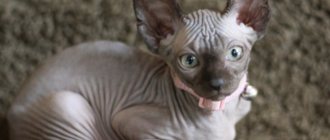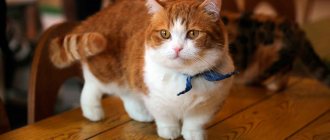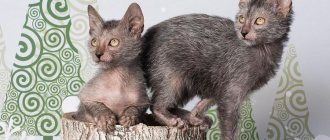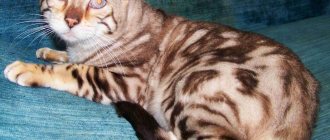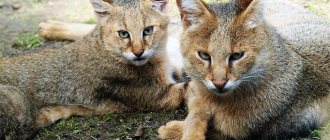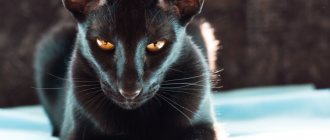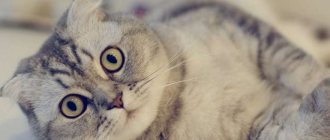Domestic cats differ not only in appearance, but also in character. These pets may show signs of aggressiveness or, conversely, absolute love for humans. The latter quality is very clearly demonstrated ragdoll cat or the rag doll breed. The name Ragdoll itself is translated into Russian as a patchwork doll. And this fully reflects its essence. In the hands of a person, a cat turns into a pliable creature and allows you to do anything with it. The explanation for this trait can only be found in the fact that animals completely trust people and enjoy communicating with them.
Origin story
The breed was formed in the 60s of the 20th century in the USA in the state of California. The appearance of Ragdoll cats is due to the breeder of Persian cats, Ann Baker, and her neighbor, who had a cat named Josephine - a cross between Persian and Angora breeds. Baker noticed that the kittens that are born to a beautiful neighbor's cat are distinguished by a particularly calm character and also attractive, but different in appearance. The breeder purchased some of them to create a new breed, which she succeeded in doing.
Amazing Grace
Baker, either out of eccentricity or for publicity purposes, began to surround Ragdoll with various myths. In some interviews, she claimed that the cat from which the kittens were originally obtained was hit by a car, and at the veterinary clinic where she was treated, the CIA conducted genetic experiments on her.
According to the story, as a result of this, she began to have special offspring with an incredibly calm disposition and decreased muscle tone. Later, the breeder began to develop the idea that the breed was alien.
Whatever prompted such stories, one thing can be stated is that representatives of the breed are very different in character and a number of physiological indicators from other cats.
Experts associate this feature of Ragdolls with the fact that the cat Josephine, the ancestor of the breed, simply had a number of recessive genes that were passed on to her kittens. Among them, Ann Baker chose those in whom they manifested themselves most strongly, and used them for mating in order to consolidate the necessary qualities in the next generations.
To obtain a new breed, kittens were initially taken that were born after Josephine was mated to a Burmese cat, the color of which included charcoal gray. Next, Baker, in order to increase the variability of colors, added Burmese with brown coat color. Since records of the first matings were not kept, it is impossible to say with certainty whether purebred cats were used or not.
Mechanical mice, electronic or automatic, what toys for cats are there and how to choose them
In 1971, the breeder created its own registry, which was named the International Ragdoll Cat Association (IRCA). Thanks to this, Ann Baker for a long time had the opportunity to control the standard of cats and the Ragdoll brand, which allowed her to sell franchises for breeding cats to breeders who paid fees and deducted 10% of the cost of the kitten sold. It was impossible to obtain animals for breeding under other conditions. The association created by Baker was not recognized by the main felinological organizations, both US and international.
In 1975, dissatisfied with the way Baker was doing business and her claims about the origin of the new breed, the shareholders of her society and its breeders broke away and organized their own society, called Ragdoll (RFCI). Its creators saw the official standardization of the breed and its recognition by felinological associations as the main task. The break with the organization created by Baker led to a serious scandal and litigation that lasted for several years.
The breed was recognized by major felinological associations in the United States in 2000. At the same time, Ragdolls took part in the championship of the International Association for Breeding New Breeds of Cats. Difficulties in recognizing this breed were associated not only with the fact that there were constant legal proceedings, but also with the fact that in appearance these cats were largely similar to the Burmese breed, which is why judges often had difficulty identifying them.
Also, some unscrupulous breeders of Burmese cats presented kittens that did not meet the standard of their breed as Ragdolls. In a number of organizations, difficulties with registration arose due to the similarity of the new cats with the Balinese breed.
This is interesting! Due to the external similarity of Ragdolls with Burmese and Balinese, the breed still raises questions among a number of felinologists today.
Despite all the difficulties that arose when registering a new breed, there are its lovers all over the world. These smart, loyal and gentle pets immediately won the hearts of cat lovers. Ragdolls appeared in Russia no more than 10 years ago, and already during this time the breed has become one of the most popular.
Characteristic
| Characteristic | Indicator on a five-point scale, where 5 is the maximum indicator |
| Activity In the house On the street | 2 1 2 |
| Shedding | 4 |
| Health | 2 |
| Playfulness | 4 |
| Intellectual abilities | 4 |
| Affectionateness | 4 |
| Need for care | 5 |
| Friendliness | 5 |
| Sociability | 4 |
| Get along with other animals | 5 |
- The Ragdoll ranks third in size among domestic cats, behind the Savannah and Maine Coon.
- Low muscle tone leads to a constantly relaxed state, which is why the cat can go limp like a rag doll when picked up.
- The pet needs the constant attention of the owner, who is the center of the world for him.
- Aggression is absent in cats at the genetic level. She will not harm a small child, even if he behaves carelessly with her.
- Ragdolls are emotionally vulnerable cats. Frequent scandals in the owner's family can cause them severe depression.
- If other animals show aggression towards a cat, then it cannot fight back and simply tries to run away and hide.
- The pet cannot stand loneliness and may get sick.
For your information! Although a cat resembles a toy, we must not forget that it is a living creature with certain rights. Each pet may have peculiarities in behavior and character.
Advantages and disadvantages of the breed
Cons of ragdolls:
- Wool can cause allergies.
- Particularly susceptible to injury.
Advantages of the breed:
- Attachment to the owner.
- Friendliness.
- Affectionateness.
The characteristics of the breed are given in the table:
| Index | Degree of manifestation | ||
| High | Average | Low | |
| Aggression | + | ||
| Communication skills | + | ||
| Adaptability | + | ||
| Training | + | ||
| Intelligence | + | ||
| Playfulness, activity | + | ||
| Noisiness | + | ||
| Need for attention from the owner | + | ||
| Hunting instinct | + | ||
Description of what it looks like
Ragdolls are tall cats with a noble appearance and unusual blue eyes. Their color is similar to a number of breeds. The established standard differs radically from others and is strictly limited by a number of rules. Deviation from them leads to a decrease in exhibition ratings, and in the case of significant defects, to the complete exclusion of the animal from breeding.
Exhibition copy
Exhibition standards
Frame
The body is muscular, long and massive. The bone is wide. The chest protrudes forward and is powerful. The neck is strong, not long. Muscle tone is reduced and the cat's body is constantly relaxed. The stomach may be saggy.
It is especially common in cats over 8 years of age, when muscle tone decreases even more due to age-related changes.
Limbs
Paws are strong and of medium length. The rear ones are longer than the front ones. The feet are round and large. Between the toes there is dense pubescence and tufts of hair are present.
Head
Proportional, massive, with a developed chin. The shape of the muzzle is pointed with plump cheeks. Nose of medium length.
Eyes
Widely opened with an oval cut, slightly sloping towards the bridge of the nose, which gives the expression of the muzzle a slightly surprised look. The setting is quite wide. The color of the iris, depending on what light falls on it, is blue or bright blue.
Ears
Medium in size, with a wide base and rounded ends. There is a tassel at the tip of the ear. The ears are slightly tilted forward.
Tail
Long, proportionate to the body, gradually tapering towards the end. Its fur is thick and dense.
Wool
Thick, medium length, very soft. There is very little undercoat, which prevents the formation of tangles. The hair on the front legs is short, sometimes of medium length. A thick collar is formed on the neck. The length of the hair from the area of the shoulder blades to the tail increases. By the cold season, the wool becomes thicker. If a cat is outdoors, then by winter the fur also lengthens.
Warning! Today, felinological associations prohibit crossing Ragdolls with other breeds. Kittens obtained in this way are recognized as crossbreeds.
Dimensions and weight
Ragdolls are impressive with their size. The body length of a cat reaches 1 meter, and that of a female – 80 cm. The weight of a male is up to 12 kg, and that of a female is up to 7 kg. The height of the pet at the withers ranges from 30 cm to 40 cm.
Most common color
Colors
Kittens are born completely white. Their final color is formed by the age of 2 years. Later, over the years, from molt to molt, it can become deeper and richer.
Ginger
This breed does not have a red color.
Bicolor
Two-tone color with a pronounced contrast between areas of different coat colors. The white hair on the head is located in the shape of an inverted Latin letter V. The dark hair affects the forehead area, the area around the eyes, and is found on the cheeks. The back is lighter colored than the head and muzzle, and may also be spotted.
Mitted
The second name for the color is glove. Dark points are located on the head and tail. The main color is light. A white stripe from the chin runs across the chest, along the belly and ends at the base of the tail. White hair forms “boots” on the hind legs, and is present on the toes on the front legs.
White
Happens only to kittens. Adult cats do not have a pure white coat color.
Color point
With this color, the body is light in color, and there are dark points on the paws, tail and head. The mask covers the forehead area. The lightest fur is on the neck and chest of the animal.
Other
The colors listed below can occur with any of the three main options for the arrangement of contrasting coat spots, be it color point, bicolor or mitted.
- Strength The main color of the coat is “light tan”. The markings are dark brown in color. When naming a cat's color, it will sound like seal bicolor, seal color point or seal mitted.
- Chocolate. The main coat color is ivory or milk chocolate. The markings (points) are milk chocolate in color with a light base tone and dark chocolate in a dark tone.
- Blue. The main color of the coat is light gray with a bluish tint. The markings are painted dark gray.
- Lilac. The main color is white with pinkish-gray markings.
This is interesting! The mustache of representatives of the Ragdoll breed is always white, even with the dark chocolate color.
A number of European felinological associations also consider other colors for Ragdolls acceptable in their standards: tortoiseshell, tabby, red and cream. At the same time, they have not yet received full international recognition and are not recognized everywhere.
And here you can read the schedule of WCF cat shows for 2022.
Disqualifying faults
Like any breed, the “rag doll” has defects that are considered disqualifying. A cat will not be allowed to compete for the following reasons:
- insufficient tail length;
- short legs;
- sharp ends of the ears;
- stocky build;
- round eye shape;
- straight line of the nose;
- Roman nose;
- cotton wool texture;
- the presence of white hair on the tail and ears, as well as the absence of a white stripe on the chin and belly with the mitted color;
- the appearance of white fur beyond the corners of the eyes, and its presence on the paws and tail with a two-color color.
Complete disqualification, in which a cat cannot be allowed to reproduce, occurs for the following reasons:
- strabismus or other congenital defects of eye shape;
- the color of the iris of the eye is a color other than blue;
- dark patches of fur in a white V-shaped area on the muzzle;
- fingers turned outward;
- small width of the chest.
Warning! Defects of this breed include high muscle tone and an aggressive character.
Ragdoll appearance
The formation of an adult animal is completed by the age of 3. The Ragdoll has a long, muscular body with a tendency to be plump (mainly in the belly and groin area), a wedge-shaped head with a rounded muzzle, silky thick coat with a noticeable collar and “pants,” and a well-furred long tail.
Body
The elongated and muscular body is noticeably weighted at the back, while the chest is quite wide and developed, and the interval between the shoulders is equal to the width of the croup. Excess fat is often deposited on the abdomen, as well as in the groin folds. The neck is strong, short and muscular.
Head
The Ragdoll, unlike similar breeds (Siberian and Neva Masquerade), has a flat space between the ears.
The head is medium-sized, wedge-shaped, with pronounced cheeks leading into a well-developed muzzle with moderate jaws and chin. Breeding males often have more prominent cheeks. The length of the nose (with a slight break allowed) relates to its width in a ratio of 2:1.
Eyes
They have a large oval shape, located slightly obliquely and at a great distance from each other.
Ragdolls are only allowed blue eyes (the brighter the better).
Ears
Medium (with rounded tips), slightly directed forward and wide at the base. Hair grows on the inside of the ears; tassels on the tips of the ears are acceptable.
Limbs
Strong, with pronounced muscles. The back is raised towards the croup due to the fact that the hind legs are longer than the front ones. The large oval paws have fur visible between the toes.
Wool
Ragdoll hair should be semi-long or long (the latter is preferable), have a soft silky structure, and not tangle. The coat does not fit very tightly to the body and begins to move when the animal moves.
The hair on the front legs is shorter than on the hind legs, where it often folds into characteristic “pants.” More abundant fur is observed in cats living in northern regions. Ragdolls shed heavily in summer.
Colors
Ragdolls are recognized by all serious felinological organizations, which do not stop discussing only the “legitimate” breed colors. So far, the CFA and WCF are winning the color dispute, having determined 4 main colors for ragdolls - charcoal gray, lilac, blue and chocolate. European associations add red, tortoiseshell, cream and tabby colored animals to the list.
In general, ragdolls are allowed to have the following colors:
- color point – dark brown (seal), chocolate (chocolate), blue (blue) and lilac (lilac);
- color point with white (bi-color, mitted);
- red, cake point, cream;
- any variants of tabby point and all its combinations with white (mitted, bi-color).
There are 3 possible color classes for the Ragdoll breed.
Color point
Differs from the generally accepted color point color:
- The mask is present on the forehead, but does not extend beyond the middle of the ears;
- There is a small light area at the base of the ear. The neck, chin and chest area are always much lighter than the markings.
Mitted
The mask covers the forehead, cheeks, whisker pads, nose and eyes, without affecting the light area at the base of the ears. The chest, neck and chin remain white. The lower part of the neck is sometimes marked by a white line running between the forelegs through the belly to the root of the tail.
The body color becomes lighter from the back to the sides and belly. The front paws are decorated with identical white “gloves”. Where white fur grows, the skin has a pink tint. The hind legs are completely white, except for the area above the middle of the thigh. Only white hair is also allowed around the knee joint.
Bicolor
The coat is well colored. The color of the points (mask, ears and tail, with the exception of the "L" on the face) should stand out clearly. A light area remains at the base of the ears. On the muzzle, a symmetrical white triangle is allowed, “superimposed” on the nose, whisker pads, lips, chin and flowing into a white “frill”. The “L” symbol on the muzzle can reach the width of the outer corners of the eyes and must be strictly symmetrical. The chest, belly and four legs are painted white.
The back may be slightly lighter than the points, but not pure white. White and colored spots (of different configurations and sizes) are allowed on the back. The standard does not stipulate the ratio of pigments.
Interesting photo
Handsome color point
Walks only on your own territory
The main advantage is the rich wool
Very beautiful mask
Friendly pair of Ragdolls
How long do they live?
The life expectancy of representatives of the breed largely depends on the correct conditions of detention and whether the pet is neutered or not. On average, Ragdolls live from 11 to 15 years.
Not castrati
Non-castrated cats and non-sterilized cats, if they do not participate in breeding and cannot realize their natural instinct to reproduce, live 2-3 years less. This is due to frequent fluctuations in hormonal levels and the development of pathologies of the reproductive system, due to the inability of its proper functioning.
Castrati
Spayed and neutered pets do not suffer from hormonal surges. They feel calm throughout the year, and their risk of developing cancer is reduced. With proper care and proper nutrition, these cats live longer.
For your information! The opinion that due to castration and sterilization cats and female cats begin to get sick is erroneous. With proper care, pets' health does not suffer.
Purchasing a kitten
It is advisable to buy an animal from reputable breeders. The seller is obliged to inform the new owners about all defects of the breed, vaccinate the kittens, and provide the pet’s passport and birth certificate.
When making a new friend, you should definitely ask about his health, character and habits. It is advisable to find out all the features of the four-legged dog immediately, so that there are no surprises or surprises later. In addition, buyers must be provided with information about his parents. Good care and nutrition will allow Ragdoll cats to live from 16 to 19 years. On average, the breed lives 11-15 years .
Varieties
This breed does not have any varieties as such. At the same time, sometimes associations can distinguish between American and Canadian lines of Ragdolls.
Canadian or American
Sometimes there are two directions for representatives of the Ragdoll breed, which is simply due to the decision of a number of federations of felinologists. In reality, these are the same cats. They do not have any significant differences between themselves.
Short-haired or long-haired
There is no short-haired Ragdoll cat! Just like the Nibelung or Ragamuffin, they always have fluffy long hair, which in its qualities resembles that of a rabbit. It does not get lost and is very pleasant to the touch. If someone tries to sell a short-haired cat as a Ragdoll, then at best it is a cross between this breed and another, and at worst it is simply a mongrel kitten with a somewhat similar color.
This is a very calm breed
What are the features of keeping ragdolls?
The main feature of Ragdoll cats that should be taken into account when keeping them is their muscle relaxation. Because of this feature, ragdolls do not know how to group in the air, like cats of other breeds, and jumping is also difficult for them. Falling even from a small height (about 1 meter) can cause serious injury to pets, so you should not throw cats on the floor
In addition, children should be taught the importance of caring for animals.
It is also necessary to prepare the house: equip windows with anti-cat nets, remove dangerous substances and objects from the ragdoll’s access area, secure wires, purchase and place “cat” accessories, remove plants to an inaccessible height, and take other measures to ensure the comfort and safety of the pet.
The content should also take into account the vulnerability and sensitivity of cats of this breed. Swearing and screaming can make Ragdolls feel very sad. They also do not tolerate loneliness very well. Breeders say that a bored ragdoll seems to lose weight and waste away before our eyes. In addition, if they are left alone for a long time and often, their character may deteriorate.
Toys do not save ragdolls from loneliness, as they need communication. Cats can be kept company not only by people, but also by cats, dogs, and sometimes even guinea pigs, if they are not in a cage. If it is not possible to provide ragdolls with company, then you can take them with you. Interestingly, ragdolls can show surprising indifference to new surroundings if they are close to their owner. They can be taught to walk on a harness (it is better not to use a collar).
It is important to remember that for the safety of ragdolls, they should not be allowed outside without a leash. Walking in the enclosure is acceptable, but it must be appropriately equipped
Please note that before visiting the street, the cat should receive a set of necessary vaccinations.
A visit to the veterinarian, timely vaccination, as well as the love and attention of the owners are important conditions for proper maintenance.
Character
These cats are particularly tender and delicate. They are smart, thoughtful and not without self-esteem. It is completely unusual for them to show aggression towards animals and people, and loud noises and scandals can hurt their psyche.
If another pet shows an aggressive attitude towards them, then Ragdoll will simply quickly move away from him, often shaking his paws with disgust.
In relation to the owners of the cat, it reveals its unusual character with canine devotion, but at the same time independence. They willingly accept affection and have a hard time withstanding loneliness, but at the same time they do not impose themselves on a person and do not bother them, demanding constant attention.
The pet will not show unceremonious persistence, but by its appearance it will show that it would like to be cuddled and, if it is allowed to do this at the moment, it will willingly begin to communicate.
Ragdoll tries to constantly be close to his owner, but at the same time without interfering with his business. Without an invitation, the cat will not even sit in your arms.
Warning! Loneliness for representatives of the breed is a real tragedy, and in the absence of the owner, they can even refuse food and water for several days.
Ragdoll kittens, like all others, are playful and active. Adult cats are very phlegmatic, although they will almost never refuse calm play with their owner. The peak of activity for these pets occurs in the evening and early night. At this time, they like to explore the house, when all the other inhabitants have already fallen asleep.
The high intellectual abilities of the breed's representatives allow them to very quickly master the tray, scratching post and get used to the rules established in the house. The owner’s speech is remembered in a short time, and the pet begins to understand entire phrases.
This is interesting! Ragdolls try not to upset their owner and fulfill all his requirements as accurately as possible.
If you wish, you can teach your pet several tricks, but only those that will suit the calm nature of the cat. These should be actions that do not require active movements.
Children can sometimes perceive a cat as a toy due to its irresponsibility. Therefore, adults should immediately explain to them that the cat is alive and needs to be treated with respect. If children are still small and may behave carelessly when playing with her, adults need to monitor their communication with their pet and guide it in the right direction. Ragdolls have a lower pain threshold and a delayed reaction, and they themselves cannot always react in time to a child’s hug that is too strong, which can result in injury.
Why doesn't he sit in my arms?
The independence inherent in a cat's character is also evident in this breed. The cat often tries to settle down next to the owner, but not on his lap. The significant size of the pet also contributes to this. It will also behave calmly in a carrying bag during a long trip.
The cat will not try to be picked up even if the owner often gets up and can push it to the floor. In such a situation, Ragdoll, due to the innate relaxation of his muscles, finds it difficult to regroup in time, and he can get seriously injured by falling to the floor like a sack.
They get along well together
If there are two in the house at once
It is not uncommon to purchase two Ragdoll kittens at once. This is a good solution, since in this case each pet will receive full communication with a fellow pet, which will have a positive effect on health.
It is especially important to have two cats if the pets have to be left alone at home for a long time.
Thanks to their calm disposition, these pets will not cause the owner any more trouble than if they had only one cat. It is worth purchasing kittens from the same litter to reduce the stress of changing homes for them.
Attitude towards children and other animals
Ragdolls are especially friendly towards other pets and children, whom they will love if they treat their pets kindly. You shouldn’t expect that a cat will be able to stand up for itself and deal with rough play by a child or attacks by an animal living in the house.
Other Features
Representatives of the breed love to talk with their owners. They sing and meow softly when you communicate with them - cats have a quiet and gentle voice. Their nature is particularly vulnerable. It is unacceptable to shout or swear at pets. This will cause severe, prolonged depression. Harassment towards Ragdolls is strictly prohibited. This can cause mental disorders and heart pathologies due to anxiety.
Advice! If you are not sure that you will be able to provide your pet with sufficient peace of mind, preference should be given to another breed.
What Ragdoll cat owners say
Many owners note that this breed likes to turn gray on its arms.
Happy owners of this cat breed speak well of their pets, speaking about them with tenderness and love:
Alyona. “I got myself two Ragdoll cats. They are slightly different in character, but at the same time very similar. I would like to note the easy trainability of this breed - they go to the toilet exclusively in the litter box, and are never mischievous. They love to sit on their arms and purr. They follow me all over the apartment. I have a cat and a kitty. The cat is more active and loves to wake me up in the morning with his tender soft paw. Often plays with a ball. The cat is calmer and puts me to sleep with her purring.”
Best Owners of a Welsh Corgi Cardigan?
Tusya. “This breed of cat has a stunning silky coat that is pleasant to the touch. My beauty is already three years old, she is very cute
The cat loves attention from its owner and other people. I don’t tolerate loneliness very well, I get very bored, but fortunately I have the opportunity to be at home and not leave her
The cat likes to play with whatever is available, so it is not necessary to purchase toys from a pet store.”
Nastya. “Recently, this cat breed has become my favorite in the whole world! A miracle happened - they gave me a Ragdoll kitten. This is a pretty, cute, little bundle of happiness, affectionate and gentle. My cat's name is Murzik, and he is only seven months old, but he is already showing his intelligence. A very smart cat breed! Ideal for children. The children played with him and often pulled his tail, at first he scratched them a couple of times, and then he began to tolerate it.”
You will also be interested in watching a video about this cat, from which you will learn some more useful information, we wish you pleasant viewing.
https://www.youtube.com/watch?v=OhFNwupQKJ8
Health, diseases, what causes people to die
Genetic characteristics that affect the muscles of an animal lead to a susceptibility to a number of diseases. It is transmitted hereditarily.
- Hypertrophic cardiomyopathy. With pathology, thickening of the walls of the heart muscle occurs, most often of the left ventricle. The right ventricle is rarely affected.
- Dilated cardiomyopathy. The cavity of the left ventricle, or both ventricles, expands, which disrupts their contractile function. As a result, congestion in the heart region, heart failure and thromboembolic syndrome develop.
- Restrictive cardiomyopathy. The walls of the ventricles of the heart turn out to be pathologically stretchable, which is why the organ stops working fully.
- Hip dysplasia. A congenital disease that disrupts the process of development and primary formation of the joint. Increases the risk of dislocation and subluxation, and as the disease progresses, it leads to problems with movement.
- Periodontitis. Inflammatory gum disease, which can be prevented by regular brushing of your pet's teeth.
When purchasing a kitten, it is worth seeing the medical record of its parents. If they are healthy, then the risk of your pet developing diseases is reduced.
It is better to comb with a furminator
Health and life expectancy
Ragdoll cats have good health and, with good care, live 13-15 years. Among hereditary diseases they are susceptible to:
- hypertrophic cardiomyopathy;
- hip dysplasia;
- polycystic kidney disease.
Some diseases do not appear for a long time, so it is very important to regularly bring your cat to the veterinarian for a preventive examination.
To protect your pet from viral and parasitic infections, it is necessary to limit free walking and promptly carry out deworming and flea treatment.
Red golls have poorly developed vestibular apparatus - so you should not buy them high cat houses
Care
Caring for a pet will require a lot of time from the owner. Because of this, if you are not sure that it will be enough, you should choose a simpler breed. It is necessary to take care of your Ragdoll systematically, otherwise your pet may get sick.
Wool
Long and thick wool requires mandatory combing. Even if there is no tendency to form tangles, without this procedure it will lose its attractive appearance. Also, due to the fact that the falling hairs will linger, clinging to the growing ones, the cat will constantly leave hair around, clinging to clothes and upholstery. During the molting period, combing is carried out at least 3 times a week; the rest of the time, once every 7 days is enough. Your pet should be accustomed to the procedure from an early age.
Advice! Cats don't like slickers. Furminator combs are most suitable for grooming hair.
Rarely, a tangle may appear. It must be removed quickly, otherwise there is a risk of skin problems. If you cannot comb it, then you need to cut off the matted fur using small sharp scissors or a special tangle cutter tool.
Bathe your pet 2-3 times a year. It is not advisable to use flea shampoos; Ragdolls often have severe allergies to them. You should not wash your cat with human shampoos, even children’s shampoos. You need to purchase products for long-haired cats for your pet, preferably hypoallergenic.
Grooming doesn't end there. Dry it with a terry towel. Using a hairdryer is possible if the pet is not afraid of it. The device is set to gentle mode.
In the summer heat, it is permissible to trim your cat with a clipper to prevent overheating. By winter, new fur will grow, which will be no worse than the previous one.
If the scratching post installed for your cat is ineffective, it is recommended to trim the claws a couple of times a year with a special tool. This procedure is not required if you buy a normal scratching post.
While licking itself, a cat swallows a significant amount of hair. To remove it from the stomach, special pastes should be used.
Walks
Free walking of cats of this breed is strictly prohibited. Due to low muscle tone, any fall will cause your pet to be injured, as it will not be able to roll over in the air. Walking in the fresh air is beneficial for cats. You should walk your pet on a harness or in your arms. Ragdolls need to be leash trained from an early age.
What to feed
The cat's diet should be balanced and complete. If ready-made diets are used, then you should choose super premium food. Proteins in the diet should make up 40% of its volume.
Advice! The breeder from whom the kitten is purchased can advise you on what ready-made food is best to use for your pet at different ages.
The natural diet is prepared separately for the cat. These are not products from the owner's table. You can give Ragdoll:
- lean boiled meat;
- boiled eggs, preferably quail, 2 times a week - no more often;
- dairy products;
- boiled vegetables can be given daily;
- boiled sea fish every 7 days;
- porridge (buckwheat, rice and oatmeal) – it makes up up to 25% of the diet.
There must be water constantly. Change it at least once a day.
Adult cats need to receive 300 g of food per day, divided into 2-3 meals, and kittens - 120 g. Growing Ragdolls are fed up to 3 months 6 times a day, and from three months to 9 months - 4 times a day. Then they switch to the adult feeding regime.
It is best to purchase an automatic cat feeder, with which your pet will always be fed as many times a day as necessary, at the same time, and during your absence too. It also wouldn’t hurt to add a fountain drinker that will provide him with clean, filtered water.
When feeding naturally, it is necessary to additionally enrich the pet’s diet with vitamins and minerals.
It is necessary to constantly provide a clean tray for the cat with a special filler, otherwise she will arrange a toilet in any other place she likes. Currently there is a large selection of different trays and automatic toilets. If your cat doesn't like her litter box, then it might make sense to replace it with another one. If you don’t want to deal with the daily unpleasant routine, you can retrain your cat to go to the toilet on the toilet.
Diet features
For the Ragdoll, proper balanced nutrition plays a huge role. A kitten up to 4-5 weeks of age should be fed exclusively on its mother's breast milk. It provides the right combination of all the nutrients your baby needs to grow into a healthy adult cat. Breast milk also contains antibodies necessary to prevent the development of the disease.
During the growing stage, the kitten needs to be provided with additional food. Immediately after mother's milk, you can feed the baby canned food diluted with water or other milk (but not cow's milk, it can cause indigestion). Your personal veterinarian can tell you more precisely about the size of portions and frequency of feeding after meeting the animal.
When a cat reaches about ten weeks of age, she should be ready to eat dry and canned food. You can start by choosing a brand of cat food from the pet store. Choosing a brand is a complex process that includes many factors.
Ragdolls need a lot of protein. It is very important for the muscle, and therefore the overall health of the animal. The easiest way to get it is from ready-made canned cat food. Dry food typically contains more grains and other fillers. Ragdolls should avoid this kind of food. But feeding dry food balanced to suit your Ragdoll's needs will help maintain healthy gums and maxillofacial muscles.
Best American Bully Health
When choosing canned food, carefully study the label. It will indicate the daily allowance depending on the weight and age of the animal. If your cat has any health problems, your veterinarian may recommend the use of dietary supplements. Cats, just like people, need vitamins and minerals and this should also be taken into account when choosing food.
Store food correctly. Animals do not like stale food. Food should be protected from flies, insects, rodents and other pests to avoid contamination that could lead to poor pet health.
Mating, pregnancy and childbirth
Representatives of the breed are characterized by constancy, and the cat is often faithful to the female throughout his life. The minimum age of a cat at the first mating should be at least 1 year, and ideally one and a half to 2 years. A cat can be allowed to breed from a year old, and especially active males can be bred from 10-11 months.
When keeping a male cat together, you can observe how the male takes care of the pregnant female. The gestation and birth of kittens normally does not differ from how this process occurs in other breeds. Not only the mother takes care of the offspring, but also the father, who licks the kittens, warms them and plays with them.
If the mother cat does not have enough milk, it is recommended to supplement the babies with a special cat milk substitute.
Read more about feeding pregnant and postpartum cats here.
What to look for when choosing a kitten, prices in rubles for kittens in Russia and abroad
Ragdolls are not yet numerous in Russia, and there are often unscrupulous sellers who, under their guise, sell kittens of other breeds with a similar color. You should buy a pet from a nursery that can provide all the documents for the animal, and show the pedigree of the parents and permission to breed this breed. Refusal to show documents is an indicator of the seller’s dishonesty.
How to properly feed a 1 month old kitten without a mother at home
Kittens born white begin to show the first signs of their future color at 2-3 weeks. By the time of sale, it is already clear what appearance can be expected in the pet.
If you are purchasing a cat for your home and do not plan to take it to exhibitions, then you should choose a pet class. Its representatives may have some external deviations in color from the standard. They are usually subject to sterilization, after which a pedigree will be issued. Their price is lower and starts in Russia from 20,000 rubles. To participate in breeding and exhibitions, you should buy a breed or show class kitten, the price of which starts from 60,000 rubles. Buying a purebred pet from abroad will cost even more. On average, you will need to pay 30,000 rubles for a pet class kitten. The higher price is also due to currency differences.
When purchasing a Ragdoll, you need to make sure that its eye color is blue or blue. You also need to hold it in your hands to understand whether it belongs to the breed: if the future pet is completely relaxed, then it is a “rag doll”.
Externally, the kitten should look healthy. He should have no discharge from his eyes, nose, or ears. In addition, the presence of parasites on it is unacceptable. A healthy kitten is usually playful, since the desire for complete peace is inherent in adult Ragdolls.
Difference from Burmese
Breeding
Breeding Ragdolls on your own is quite problematic. Breeders note that it is very difficult to find a worthy partner - false ragdolls are often found. Crossing with other breeds is prohibited. When selling kittens for breeding, nurseries are equipped with microchips.
Ragdolls are monogamous. A male can live with one cat his entire life, preceding mating with long gentlemanly courtship that can last for years. The heat occurs calmly.
Nurseries in Russia engaged in breeding the breed are few in number. In Moscow it is:
- Albus Angelus*ru;
- Great Delight;
- Ragdollcatdoll;
- Sundoli cats.
Differences from other breeds
Experienced breeders can easily distinguish Ragdolls from other breeds. If a cat is purchased simply for oneself, then in order not to encounter deception, one must take into account the main characteristics that distinguish representatives of this breed from others.
Siamese
Siamese cats are smaller than Ragdolls and the vast majority have smooth coats. Long-haired Siamese cats are very rare. They can fight back and will never allow themselves to be treated like a toy.
Neva Masquerade
The main difference is the muscle relaxation of Ragdolls. The Neva Masquerade will not hang like a “rag doll”. She is muscular and hard, and if she wants to break free from her hands, she will do it without difficulty. Ragdolls have a more docile and peaceful character, and their fur is shorter.
Burmese
The main difference is the size. Ragdolls are larger and heavier, which is already visible in kittens. Their offspring are more massive than those of other breeds.
Other similar
Sometimes a “rag doll” can be mistaken for a Maine Coon or Siberian cat. However, these breeds are not characterized by the color that Ragdolls have. This is the first and most pronounced difference, which is immediately visible.
Advantages and disadvantages
| pros | Minuses |
| Kindness and affection towards the owner | Intolerance of loneliness |
| Get along with other pets | The need to strictly adhere to proper feeding |
| Complete absence of aggression towards children | High risk of injury from any fall, even from very low heights |
| Quiet voice | Reduced pain threshold, due to which the cat can be accidentally injured by a child |
| No tendency to form tangles | Inadmissibility of free range |
Description of the Ragdoll breed
Standard
- Body: Ragdolls are large, strong cats. The width of the croup and shoulders is the same. The limbs are medium, the forelimbs are slightly shorter. The weight of the male is 7-10 kg, the weight of the female is 4-6 kg. The tail is long, the hair on it is uniform.
- Head: wedge-shaped. The cheeks are developed. The profile is not sharp. The forehead is rounded. The bridge of the nose is concave.
- Ears: medium, wide base. Wide apart with a slight forward lean. The tips are rounded. The inside is covered with wool.
- Eyes: oval, blue. The more intense and brighter the eye color, the better.
- Coat: Long, silky and rabbit-like. There is practically no undercoat. There are tufts of fur between the fingertips. A characteristic feature of ragdolls is their woolen collar and pants.
Ragdoll cat coat color:
- color point - dark mask to the middle of the ears;
- bicolor - there is white hair on the head in the shape of an inverted V, starting from the forehead, moving to the chest, including the muzzle and cheeks;
- glove color or “Mitted” - symmetrical white “gloves” on the front legs and “boots” on the hind legs, connected by a continuous white line along the belly to the chest.
There are 4 recognized primary colors that make up the color (but their combinations are not specified by the standard):
- lilac;
- chocolate;
- blue (blue);
- "strength".
Photos of colors
The breed standard does not allow a pronounced stop in the profile. Disadvantages are also considered to be a thick undercoat, narrow or almond-shaped eyes and a Roman nose.
Health
The breed got its name due to the ability of cats to completely relax their muscles. It is believed that low tone is the reason cats are unable to roll over in the air. Therefore, when falling from a height, ragdolls are seriously injured. However, this is not an established fact. Some breeders note that their pets have a good reaction. However, leaving your cat at height is not recommended.
Diseases characteristic of this breed
Among cats of this breed there are individuals diagnosed with hip dysplasia. Its extreme manifestations are lameness and complete immobility. Another serious diagnosis is hypertrophic cardiomyopathy. Usually appears with age.
Otherwise, ragdolls delight their owners with excellent health. The average life expectancy of Ragdolls is 12-15 years.
Although, due to their nature, some pets hide their ailments, and they need to be treated with increased attention
Character
Ragdolls are some of the best companions. The character of these pets is often compared to that of a dog - cats are very attached to their owners, follow them from room to room, can distinguish shades of speech, are easily accustomed to the tray and even follow simple commands.
Their trust in their owners is limitless. Long separation has a detrimental effect on the animal’s condition and can cause deep depression. Therefore, it is better to take your cat with you on a long trip; thanks to its high adaptability, it will not cause any trouble. Absolutely not aggressive, friendly, they are well intellectually developed. They have a pleasant, soft timbre of voice, which they use extremely rarely.
There is an opinion that ragdolls are lazy cats, but this is not entirely true. The animal's activity is average. They are playful as teenage kittens and retain this trait into old age. Breeders note that Ragdolls show interest in all household chores.
Best Hairless Sphynx cat
Peaceful "rag dolls" get along well with children and other pets. The owners note that despite their clear self-determination in the house, cats never enter into conflict and try to solve their problems in a peaceful, “roundabout” way.
Of course, there are basic precautions for all breeders. You need to introduce the cat to the newborn gradually, first letting him sniff his things, and then him, gently holding the animal by the paws.
It is worthwhile to observe for some time how the pet reacts to the new family member, whether it shows jealousy
It is also important to feed the baby and the cat at different times so that she does not feel competition. If there is a child under six years old in the house, it is better not to leave him alone with the cat unattended
Like any cat, ragdolls love to enjoy peace and quiet.
Therefore, it is important that your pet has its own secluded corner. It is worth noting that this breed does not like loud sounds and screams.
Interesting Facts
- The cat is resistant to pain and has an inhibited reaction, which is why it may not respond to a child playing with it for a long time.
- Lack of fear. For representatives of the breed, a feeling of fear is not typical, which is why they are almost never able to recognize a threat in time and can easily get hurt.
- Hypoallergenic. This breed practically cannot cause allergies.
- Ragdolls were used to create a new breed, the American Bobtail.
Is it worth starting
Ragdolls are unique cats that require proper care and special care from their owner. They are suitable for those who can provide their pet with complete safety from injury, taking into account its characteristics and the constant company of another animal or family member. This is an unusual cat, it will thank a person with devotion and tenderness, but on the condition that it is treated properly. Ragdoll should not be purchased as a toy for children, taking advantage of its peaceful nature. First of all, it is a living being with its own feelings and rights, which is important not to forget.


